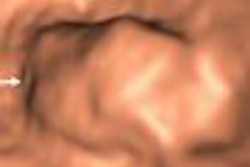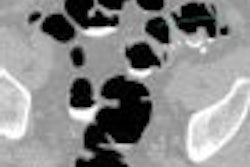The need to eliminate misunderstandings about the radiation dose of advanced imaging exams persists, especially as the number of studies rises. But when is information truly useful, and when is it confusing? And who should be providing it?
Imaging utilization management firm American Imaging Management (AIM) of Chicago took a stab at the issue with the February launch of a patient exposure tool on its Web site. The tool is aimed at making radiation exposure more understandable for physicians and consumers, but has been drawing criticism from radiologists for what some imaging experts see as questionable comparisons.
When a study is chosen with the tool, an avatar, called "Aimee," that shows the appropriate body part for the exam. The tool provides common uses for the study and offers alternative exams. It estimates "exposure levels" for each exam, and lists the "chest x-ray equivalent" radiation dose, as well as a "natural environment" exposure number measuring the number of years it would take for the patient to receive an equivalent dose from naturally occurring background radiation.
Criticism includes what some perceive as inappropriate ownership of the site because of AIM's affiliation with WellPoint of Indianapolis, a health-benefits company that bought AIM in 2007. AIM calls such accusations "cynical," and underscores the company's volume of information and experience in imaging management.
"The information we're providing is consistent with other sources of that information, so to say that it isn't valid just because of who we are is off the mark," said Paul Danao, AIM's vice president business management.
Suggested changes
Some radiologists say the tool's information sources need to be clarified. Critics also target the lack of explanation for variations in radiation exposure, which depends on equipment and patient.
Some clarifications will be made to the tool in the coming weeks. But Danao said that is not to say that AIM doesn't "feel comfortable" with the current numbers.
However, some experts are concerned the complex material has been oversimplified and could be misleading.
"You can't just throw out a radiation exposure number for a given procedure," said Dr. James Thrall, vice chair of the American College of Radiology (ACR) of Reston, VA, and radiologist in chief at Massachusetts General Hospital in Boston. "You have to know what protocol is being used by the provider."
Instead of comparing the imaging exam to chest x-rays and natural radiation, Richard Morin, Ph.D., chair of the ACR's Safety Committee and professor of radiologic physics at the Mayo Clinic in Jacksonville, FL, suggests an alternative.
"They certainly could have lumped (the estimates) into high, medium, and low relative radiation levels," Morin said. "That's what the ACR does for their Appropriateness Criteria. Each examination is given a relative radiation level, so an ordering physician could see the radiation level for a CT of the head was higher than a skull x-ray."
The inherent problem with numeric estimates such as the ones on AIM's site is that they could have relatively large ranges, depending on the patient.
"Attaching these numbers to various procedures and presenting them in a way that appears factual could be misleading to some patients and even perhaps to some physicians who are taking a look at this, trying to judge whether or not (to) order an exam," Morin said.
Calculating what the site terms "effective dose" to equal a number of chest x-rays also draws criticism. "You don't equate a CT of the head to a certain number of chest x-rays, because the head is not exposed in a chest x-ray," Morin said. "And therefore, the biological effect is completely different. While ... (AIM) believe(s) that this is a comforting way to inform the public, it actually could be terrible misinformation."
AIM's equating of advanced scans to natural radiation is also problematic. Background radiation is a whole-body exposure that happens chronically. The biological effects are different from an acute exposure over a limited body part.
On the positive side, the site's navigability, avatar concept, and presentation of brief commentary of uses and alternatives of imaging techniques have drawn praise.
No place for supersizing
|
Alternative sources on radiation An alternative source for consumers and physicians on pediatric scanning is the Image Gently Web site at www.imagegently.org. The site was created by the Alliance for Radiation Safety in Pediatric Imaging. Adult scanning information is available at radiologyinfo.org, a site created by the Radiological Society of North America and the American College of Radiology. -- LM |
These estimates "would only apply to adult-size children," Simoneaux said. "A six-month-old is not getting the same exposure on (his) chest as the adult ... maybe vastly lower."
In addition, a chest CT is frequently accompanied by a CT of the abdomen and pelvis in many cases. That fact is often lost on the clinician who orders the study, Simoneaux said. When ordering an abdominal CT, "we're almost always going to do a pelvis (too), so you have to add those two together," he explains. "It wouldn't be clear to most people from this site."
Despite its flaws, the site addresses a hunger for information on the part of concerned parents who want to know the effects and value of imaging studies on their children, according to Dr. Marilyn Goske, the chair of the Alliance for Radiation Safety in Pediatric Imaging and a professor at Cincinnati Children's Hospital Medical Center in Ohio.
"If your child needs a CT in a specific situation, you can't go to a simple model and look at a simple set of guidelines that are written by individuals on a Web site to (determine) whether that's the appropriate test or not," Goske said. "I believe that the appropriate use of CT scanning in children can only be done in consultation with the patient's referring physician, who has seen the child, who knows the laboratory tests, and who examines the child."
Goske urges parents to learn more about their child's condition and ask very specific questions about their child's particular situation. She also wants pediatricians to use the ACR guidelines that have pediatric-specific criteria, and use pediatric radiologists as experts. (According to a 2007 article in the New England Journal of Medicine, of the more than 62 million CT scans performed per year, at least 4 million are on children [NEJM, November 29, 2007, Vol. 357:22, pp. 2277-2284].)
Raising awareness
Family physician Dr. Moitri Savard, who practices in New York City, said she would consult the AIM site to understand a patient's radiation exposure, but has a concern.
The information "may be scary to patients," Savard said. "They may not want to get a necessary examination due to radiation risk."
A recurring criticism of the site is that it fails to mention the benefits of advanced imaging and the potential necessity of studies for accurate diagnosis and treatment.
Arming the public with questions they should ask to challenge providers is crucial to raising awareness, according to Thrall. Everyone needs to recognize that unnecessary radiation is the worst kind.
"In the long run, I actually think this is very healthy to have the increased awareness," Thrall said. "But we must do it in an objective, honest way that is not colored by financial motivation."
By Lin Muschlitz
AuntMinnie.com contributing writer
April 18, 2008
Related Reading
Researchers recommend alternatives to CT, April 15, 2008
ACC news: CTA dose varies widely, could be lower, April 2, 2008
Prospective gating drops cardiac CT radiation dose, March 10, 2008
New studies examine CR, CT radiation dose, March 9, 2008
Dose studies delve into coronary CTA, March 8, 2008
Copyright © 2008 AuntMinnie.com




















